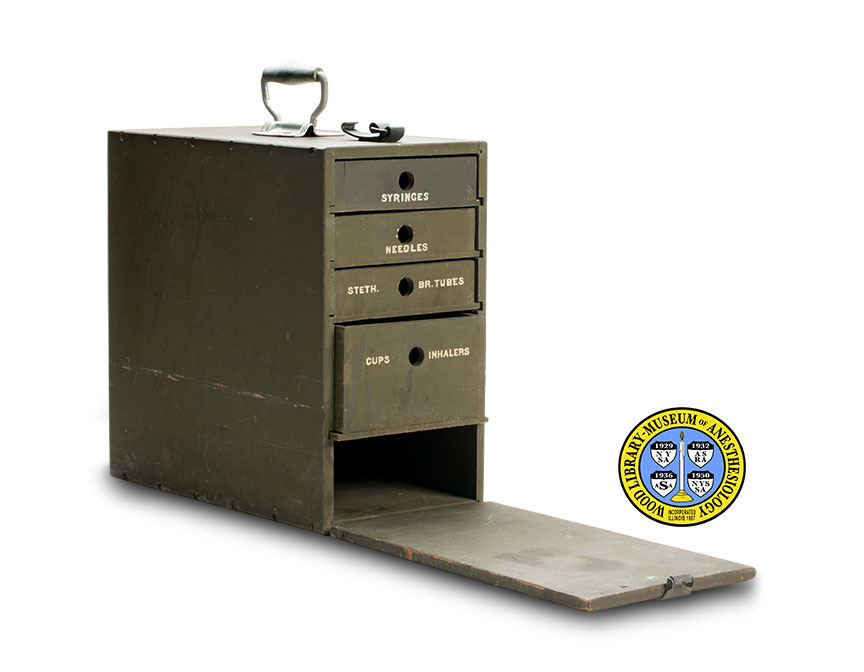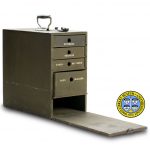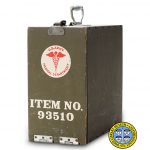U.S. Army Anesthesia Set
This wooden carrying case was part of an anesthesia set made for the U. S. Army Medical Department. Built for use in WWII, the complete set had five drawers which held an array of small equipment used by anesthesiologists. These pieces included syringes and needles for administering regional anesthesia, enamel cups for dissolving those drugs that were supplied in tablet form in sterile water, an aneroid sphygmomanometer (blood pressure apparatus), a stethoscope, Yankauer Masks for administering inhalation anesthesia, Guedel Airways, and a Foregger Military Endotracheal set.
Catalog Record: U.S. Army Anesthesia Set
Access Key: almo
Accession No.: 2011-10-26-1
Title: Item no. 93510 : [anesthesia set complete] / U.S. Army Medical Department.
Corporate Author: United States. Department of the Army.
Title variation: Alt Title
Title: Army anesthesia case.
Title variation: Alt Title
Title: Anesthesia set complete : item no. 93510.
Publisher: [Place of manufacture not indicated : Name of manufacturer not indicated], [between 1939 and 1944?].
Physical Descript: 1 case for supplies : wood, metals, paint ; 40 x 21 x 40.5 cm.
Subject: Military Medicine – history – United States.
Subject: Military Medicine – instrumentation.
Subject: World War II.
Subject: Anesthesia – instrumentation.
Note Type: General
Notes: The date range for the possible year of manufacture is a rough estimate based
on the generally accepted date range for World War II and the year that the
United States Army’s Item Numbers changed from five digits in length to seven
The date range could change if documentation indicates that it should be
corrected.
Note Type: Copyright
Notes: The title is based on markings on the outside of the set and documentation
found online (see citations below).
Note Type: Citation
Notes: Background to medical item numbers. WW2 US Medical Research Centre website.
https://www.med-dept.com/articles/background-to-medical-item-numbers/.
Accessed April 6, 2015.
Note Type: Citation
Notes: Instrument sets & contents: medical kits & contents. WW2 US Medical Research
Centre website. https://www.med-dept.
com/medical-kits-contents/instrument-sets-contents/. Accessed April 4, 2015.
Note Type: Citation
Notes: US 1st Army. Appendix 2: equipment authorized in excess of T/E prior to D Day
First United States Army Report of Operations: 20 October 1943-1 August 1944
[Place of publication not indicated]: [Publisher not indicated]; [1944]:118.
https://history.amedd.army.
mil/booksdocs/wwii/FUSARPTOct43Jul44/FUSARPTOct43Jul44.html. Accessed
February 13, 2015.
Note Type: Physical Description
Notes: One wooden case for storing and transporting common supplies required to
administer anesthesia; the case is painted dark green and has a metal
carrying handle at the top; For the purposes of this description the side
with the military markings will be considered the front of the case; The
measurements 40 x 21 x 40.5 cm were taken with the case closed; The paint is
worn, scuffed and scratched; On the front is a white circle marked with a red
caduceus and red lettering; The text is, “U.S. ARMY”, located above the
caduceus, and “MEDICAL DEPARTMENT” located below the caduceus; Below the
white circle, stenciled in white large letters is, “ITEM NO. [new line]
93510”; The front of the case is held to the bottom of the case with two
metal hinges, and to the top of the case with a metal clasp; The front opens
to reveal four draws and a storage compartment for medical supplies; From top
to bottom, the drawers are marked, “SYRINGES”, “NEEDLES”, “STETH.”, “BR.
TUBES”, “CUPS”, “INHALERS”. No other maker or owner marks were found on the
item.
Note Type: Reproduction
Notes: Photographed by Mr. Steve Donisch November 12, 2014.
Note Type: Historical
Notes: The United States Army identified and categorized items of officially issued
equipment using “Item Numbers.” The first number in the sequence conveyed the
class to which the item belonged. Class 9 indicated ‘field equipment and
supplies,’ while the entire number 93510 identified the item as an,
“Anesthesia set, complete.” In 1944 the item numbers were changed from five
to seven digits in length.
The set was contained in a wooden box with four wooden drawers and a
cubby-hole. It contained the basic supplies an anesthesiologist needed to
administer local, regional or general anesthesia in field hospitals during WW
II. These items included needles, syringes, airways, a Yankauer inhaler,
intubation set, sphygmomanometer and blood pressure cuff. The front of the
box was hinged and could be closed over the drawers and cubby-hole for
transportation or storage.
Note Type: Publication
Notes: Doud EA. Anesthesia. In: Berry FB, ed. Thoracic Surgery. Vol. 1. Washington,
D.C.: Office of the Surgeon General; 1963:261-266. Surgery in World War II.
https://history.amedd.army.mil/booksdocs/wwii/thoracicsurgeryvolI/chapter10.
htm. Accessed February 16, 2015.
Note Type: Publication
Notes: Wiltse CM. Central procurement of medical supplies. In: Medical Supply in
World War II. Washington, DC: Office of the Surgeon General; 1968.
https://history.amedd.army.mil/booksdocs/wwii/medicalsupply/chapter2.htm.
Accessed February 13, 2015.
Note Type: Publication
Notes: Wiltse CM. The medical supply system. In: Medical Supply in World War II.
Washington, DC: Office of the Surgeon General; 1968. https://history.amedd.
army.mil/booksdocs/wwii/medicalsupply/chapter1.htm. Accessed February 13,
2015.
Note Type: Publication
Notes: Wiltse CM. Storage and distribution of medical supplies. In: Medical Supply
in World War II. Washington, DC: Office of the Surgeon General; 1968.
https://history.amedd.army.mil/booksdocs/wwii/medicalsupply/chapter5.htm.
Accessed February 13, 2015.
Note Type: Exhibition
Notes: Exhibited at the National World War II Museum in New Orleans, October, 2014.
Selected for the WLM website.



